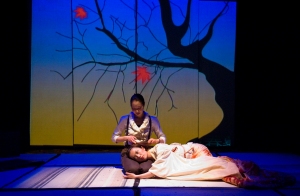by Rebecca Gwyther
As an essential part of the StoneCrabs Young Directors Programme we are introduced to industry professionals, providing us with talks and workshops that will help us with our knowledge of the industry and our job as a director. Last week Sound Designer Dinah Mullen came in to discuss the tool of sound in our work. Dinah, having worked with StoneCrabs since 2003 with The Real Princess, now does work for theatre, dance, films and audio tours with most of her time being spent with PanicLab.
Perhaps the most important part of our talk with Dinah was finding out exactly what the relationship between the director and Sound designer is. When first having the idea of a show and the possibility of a sound designer, Dinah explains “I want to be involved from the start, unless they suddenly realise they need a designer” as this makes her job easier- she can observe the work as it takes shape and “use sound as early as possible and try it out in rehearsals”.
This helps all aspects of the creative process “helping actors and director think about the connection with sound”. To even get to this stage though, Dinah stresses the importance of what she wants from a director, “lots of references and ideas of the overall design. Sounds even have temperatures and moods so you can give an overall idea of it being hot or cold, having tension or being relaxed. The more information the better”. However, as a director she understands that there are many other things going on and at that moment in time sound may not be at the forefront of our minds so “I’ll always remind directors that I’m here to help them reach their vision”.
Having a sound designer isn’t always essential, and sometimes isn’t within the budget. “Look for BA somewhere like Central or ask someone you know in theatre to recommend someone. You can use Stagejobs Pro but ideally go through word of mouth” is the advice given when asked, “how do you find a sound designer?”. We are also given the advice that if we just need a song or a sound then “to look at Creative Commons” which has filters to find royalty free work.
Some sounds are more complicated to create though, especially when you branch into layering and Foley (a sound that is happening in the space). Dinah explains that “it is the job of the sound designer to be aware of when there is too much sound” and emphasises that silence is important; it often means more to have silence than filling every second with background noise. The technical rehearsal and opening nights are essential, giving an opportunity for notes to be given although Dinah says “often I see the show more than once, especially if they move to a different venue”.
As a group we are impressed with the bizarre ways that Dinah has had to design sound. “I once had to make a sound of someone having their heart ripped out” and as she continues to explain how she used a melon and recorded herself attacking it we know that originality and being inventive is all part of the job! We were conscious of giving the sound designer artistic license to their work, but still wanting to fulfill our ideas so it is suggested to us that we give “suggestions but allow space for an offer. Then give the feedback.”

Dinah & some members of the Young Directors Training Progamme (from left to right: Femi, Katie-Ann, Rebecca, Dinah Mullen, Ria, Devan and Tom)
There are a few last words of invaluable advice that come from Dinah though mainly to be good at communication and to “have a go at Q Lab, this runs shows and can even add video cues. The more you know how it works and observe a sound designer the easier and more cooperative the relationship can be”. There is also a vital element in knowing that “a sound designer won’t be able to do everything at one moment in time”, we have to treat and respect them as artists themselves.
From Dinah’s passion for playing with music and trying things out, the connection between sound and image is what has appealed to her to become a sound designer. She says that “the best results for her come when she can entirely visualise a project”. We’ve been given a lot to think about in terms of sound design and I’m off to have a go on Q Lab before we start casting and meetings early next year!
Listen too Dinah Mullen music and read all about her work here: http://dinahmullen.com/
StoneCrabs Young Directors Trainees 2015-16 are producingHeadways, a festival of short plays at the Albany, March 2016


